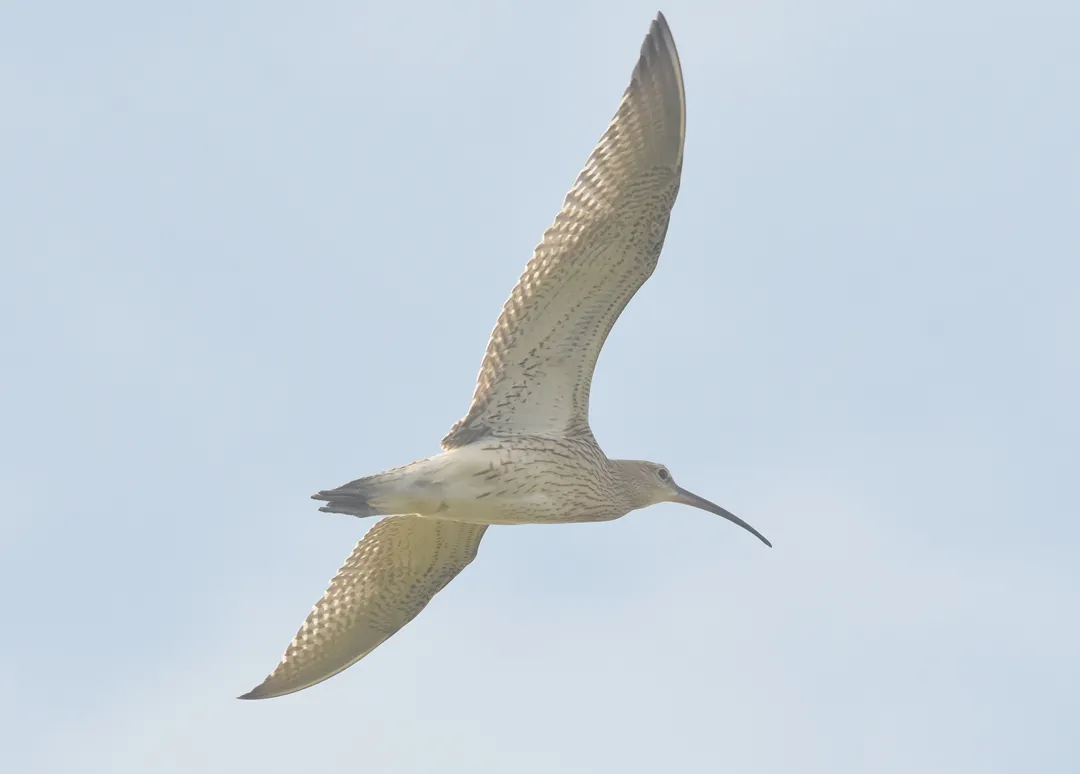Citation

Overview
A large tracking dataset was used to assess the behavioural responses of migrating Curlew to offshore windfarms, of which there are many in the North Sea and Baltic Sea. Most individuals showed medium-scale avoidance responses in the horizontal and vertical planes. Up to 15.8% of the individuals migrated at elevated risk without showing avoidance reactions. Collision risk and energetic constraints by circumventing the turbines are discussed.
Abstract
EU member countries and the UK are currently installing numerous offshore windfarms (OWFs) in the Baltic and North Seas to achieve decarbonization of their energy systems. OWFs may have adverse effects on birds; however, estimates of collision risks and barrier effects for migratory species are notably lacking, but are essential to inform marine spatial planning. We therefore compiled an international dataset consisting of 259 migration tracks for 143 Global Positioning System-tagged Eurasian curlews (Numenius arquata arquata) from seven European countries recorded over 6 years, to assess individual response behaviors when approaching OWFs in the North and Baltic Seas at two different spatial scales (i.e. up to 3.5 km and up to 30 km distance).
Generalized additive mixed models revealed a significant small-scale increase in flight altitudes, which was strongest at 0–500 m from the OWF and which was more pronounced during autumn than during spring, due to higher proportions of time spent migrating at rotor level. Furthermore, four different small-scale integrated step selection models consistently detected horizontal avoidance responses in about 70% of approaching curlews, which was strongest at approximately 450 m from the OWFs.
No distinct, large-scale avoidance effects were observed on the horizontal plane, although they could possibly have been confounded by changes in flight altitudes close to land. Overall, 28.8% of the flight tracks crossed OWFs at least once during migration. Flight altitudes within the OWFs overlapped with the rotor level to a high degree in autumn (50%) but to a significantly lesser extent in spring (18.5%). Approximately 15.8% and 5.8% of the entire curlew population were estimated to be at increased risk during autumn and spring migration, respectively.
Our data clearly show strong small-scale avoidance responses, which are likely to reduce collision risk, but simultaneously highlight the substantial barrier effect of OWFs for migrating species. Although alterations in flight paths of curlews due to OWFs seem to be moderate with respect to the overall migration route, there is an urgent need to quantify the respective energetic costs, given the massive ongoing construction of OWFs in both sea areas.
Tagging of Curlews in the German Wadden Sea and data analyses were supported by the projects BIRDMOVE (FKZ 3515822100) and TRACKBIRD (FKZ 3519861400) funded by the German Federal Agency for Nature Conservation with funds from the Federal Ministry for the Environment, Nature Conservation and Nuclear Safety and Consumer Protection (BMUV). Tagging of breeding curlews in NW Germany was funded by the German Federal Agency for Nature Conservation (FKZ 3520 53 2052) and the Lower Saxony Water Management, Coastal Defence and Nature Conservation Agency (NLWKN) with funds from the Federal Ministry for the Environment, Nature Conservation, Nuclear Safety and Consumer Protection, Niedersächsische Bingo Umweltstiftung, the Senator for Climate Protection, Environment, Mobility, Urban Development and Housing of the State of Bremen, the National Park Administration of the Wadden Sea National Park of Lower Saxony, Niedersächsische Wattenmeer-Stiftung, NRW-Stiftung, Naturschutzstiftung des Landkreises Osnabrück, Naturschutzstiftung Kreis Steinfurt, the districts of Aurich, Cloppenburg, Cuxhaven, Diepholz, Emsland, Grafschaft Bentheim, Leer and Verden. Funding in France was received by the French Ministry of Ecology (project BirdMan) and the Agence Française de Développement, (project Limitrack, grant QUALIDRIS), Contrat de Plan Etat-Région, CNRS (grant ECONAT), Ligue pour la Protection des Oiseaux as well as by the project “Applied research for conservation of the Eurasian curlew” funded by the Estonian Environmental Investment Centre (grant No. 8172). Tagging of wintering Curlews in the UK was funded by a donation to the Wash Wader Research Group.
